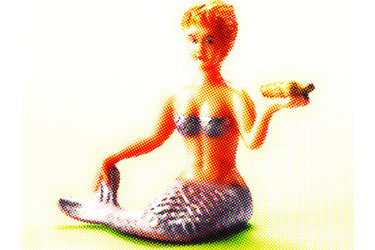ARW's C&G+RNA Manufacturing Must-Reads (The Little Mermaid Edition!)

By Anna Rose Welch, Editorial & Community Director, Advancing RNA

Day-in and day-out, I write, read, listen to, and watch as much content as I can about CGT and RNA therapy manufacturing, in particular, and/or other ATMP industry-related topics that you should at least be aware of in the manufacturing facility. Every two weeks, I compile the articles and industry updates I think are most worthy of your time into an unconventional newsletter format (below) and send them out via email.
When this newsletter was sent out — November 17th — it was the 33rd anniversary of Disney’s The Little Mermaid. So, naturally, this latest batch of manufacturing must-reads had to be a new, never-before-been-read retelling of The Little Mermaid. As it turns out, our heroine has dreams of leaving the depths of the ocean for a career in the ATMP industry. Who needs princes? Happy ever after reading!
Chapter 1: The Dream of Something Else, Somewhere Else
[MANUFACTURING/CAPACITY UPDATES]
Far out in the deepest depths of the ocean dwelled the Sea King and his daughters — the youngest of which cared for nothing of the ocean’s mysteries nor of ruling her father’s kingdom.
Instead, she was enthralled by her grandmother’s tales of the surface world. In particular, of how pharmaceutical scientists were lessening the burden of high-cost raw materials and capacity constraints, and how inflation and underfunding would impact biotech manufacturing. [Biomanufacturing Capacity Crunch Part 2: Building Optionality]
Her grandmother’s tales of scaling-out to scale-up, of developing new technologies to improve productivity, and of future company models that could support ATMP/therapeutics development gave her hope one day she would not only walk among the surface-dwellers but work in the industry of which she’d so long dreamed. [It Turns Out We Need To Make (A Huge Amount) of Stuff: Investing In & Designing for Bio-Manufacturing.]
Chapter 2: To Grow Up & Meet The FDA Faster
[REGULATORY]
“One day,” said the grandmother, “You will have permission to rise from the depths, to sit on the rocks, and watch the planes carrying executives to Washington, all the way to the FDA.”
But our heroine was ambitious and impatient. Like the FDA’s new CMC Development & Readiness Pilot (CDRP) Program, which is designed to facilitate and accelerate CMC readiness, she, too, wanted to expedite her transition to a new life on land. [FDA CMC Development & Readiness Pilot Program; Program Announcement]
Chapter 3: Negotiating To Change Her Circumstances
[OUTSOURCING]
“To save the lives of others by making pharmaceuticals I will venture all and give up my ocean birthright,” she said. “I will go to the sea witch to give me counsel and help.”
But to which sea witch should she outsource her dreams?
To go from a fish’s tail to a human’s legs is a scientific revolution yet to be mature. It would require the keenest attention to detail, nuanced foresight of scientific and technical developments on the horizon, and new styles of risk-sharing. [“Risky Business:” How Cell & Gene Therapies Are Upending Partnership Models]
The little mermaid’s heart beat with apprehension at the many (far from clear-cut) choices before her. [CMO Initial Offering: ‘Adding an ‘R’ or ‘T’ Blurs Message, Says Marketing Expert]
And though the advice of other mermaids could have provided some answers, so unique was this decision to her development and goals, she knew she had to make it alone. [CDMO Selection In Our Post-COVID World]
Chapter 4: Before Transformation, There Must Be Potency
[SAFETY/EFFICACY/POTENCY]
To find the right sea witch, she navigated through water snakes and shipwrecks, inspected many a cauldron, and occasionally encountered fearsome displays of poor potion practices.
Ultimately, the little mermaid selected a sea witch who told her, “Cleanliness is a good thing,” as she used a knot of seaweed to shine her stainless-steel cauldron.
“But so, too, is the potency of what I take,” our clever heroine said, demanding also great analytical insight and prowess to match such advanced science. [ARM/ASGCT: Potency Assay Working Session Summary]
For she knew transforming her tail into legs the most skilled dancer would envy demanded union of two equally important therapeutic parts: well-targeted vectors or nanoparticles and a well-crafted drug substance within. [mRNA Delivery Is More Than Just The Vehicle: Think Outside — & Inside — The LNP]
Chapter 5: The Great Transformation
[RNA DELIVERY]
And so, the little mermaid drank the magical draught — the savvy sea witch also had the first patent for oral ATMP delivery — and it was as if she was gently enveloped in a lipid nanoparticle. The world went soft around her, and she fell into a deep sleep.
She dreamt of her new legs carrying her through forests, deserts, cities, and up mountains —marveling at her fortune of finally arriving in such diverse, previously unreachable geographies [Delivery of RNAs to Specific Organs by LNPs for Gene Therapy]
Chapter 6: Happily Professional Ever After?
[HIRING]
When she awoke, she had been washed ashore. Where once an iridescent tail and shells was now a pair of legs dressed in a (somehow) well-ironed pantsuit with a (still working) iPhone in the pocket.
Though from an untraditional background, she knew the biopharmaceutical manufacturing hiring ecosystem — with all its flaws — was ripe for disruption. [NIIMBL: Innovation of the Biopharmaceutical Manufacturing Talent Pipeline]
The once-mermaid turned executive-hopeful opened LinkedIn and took her first steps down the beach.
